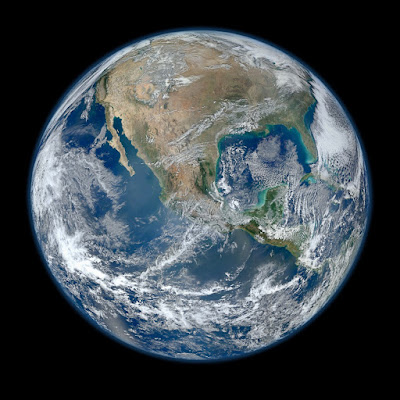Back in 2007, a book entitled The Black Swan, by Nassim Nicholas Taleb, was published. A Second Edition has since been printed. We believe it would be incredibly wise if more people read it. We wonder if, and hope that, both Biden and Harris have read it. It's pretty clear to us these days that the folks in Texas should have been more familiar with its premise and that season by season, year by year, farmers are finding more and more black swans landing in their fields. This latter assessment is based on reading Tom Philpott's Perilous Bounty, the Looming Collapse of American Farming and How We Can Prevent It.
 |
| our only home Image Credit: NASA/NOAA/GSFC/Suomi NPP/VIIRS/Norman Kuring |
The importance of the preceding was heightened yesterday when we became aware of a recently published United Nations report, Making Peace with Nature. Many of the themes parallel those of Taleb's book.
Key Messages
Summary
• Climate change, biodiversity loss and pollution add up to three self-inflicted planetary crises that are closely interconnected and put the well-being of current and future generations at unacceptable risk.
• Ambitious and coordinated action by governments, businesses and people around the world can prevent and reverse the worst impacts of environmental decline by rapidly transforming key systems including energy, water and food so that our use of the land and oceans becomes sustainable.
• Transforming social and economic systems means improving our relationship with nature, understanding its value and putting that value at the heart of our decision-making.
We haven't yet read the full report, but we suspect there are few references to profit maximization or lean supply chains. Back in the days when we were a practicing planner, before we became a recovering planner, we tried to always remember the dictum "More of the same never solved a problem." And yet, that seems to be the best our current political and business "leadership" can offer. It reminds us of the joke about the problem that can arise with a skewed reliance on faith in miracles.
IAmong starving polar bears,The only moving thingWas the edge of a glacier.IIWe are of one ecologyLike a planetIn which there are 200,000 glaciers.IIIThe glacier absorbed greenhouse gases.We are a large part of the biosphere.IVHumans and animalsAre kin.Humans and animals and glaciersAre kin.VWe do not know which to fear more,The terror of changeOr the terror of uncertainty,The glacier calvingOr just after.VIIcebergs fill the vast OceanWith titanic wrecks.The mass of the glacierDisappears, to and fro.The threatHidden in the crevasseAn unavoidable cause.VIIO vulnerable humans,Why do you engineer sea walls?Do you not see how the glacierAlready floods the streetsOf the cities around you?VIIII know king tides,And lurid, inescapable storms;But I know, too,That the glacier is involvedIn what I know.IXWhen the glacial terminus broke,It marked the beginningOf one of many waves.XAt the rumble of a glacierLosing its equilibrium,Every tourist in the new Arcticchased ice quickly.XIThey explored the polesfor offshore drilling.Once, we blocked them,In that we understoodThe risk of an oil spillFor a glacier.XIIThe sea is rising.The glacier must be retreating.XIIIIt was summer all winter.It was meltingAnd it was going to melt.The glacier fitsIn our warm-hands.
********************************************
Thanks for visiting. Come again when you can.
Please be kind to each other while you can.
No comments:
Post a Comment